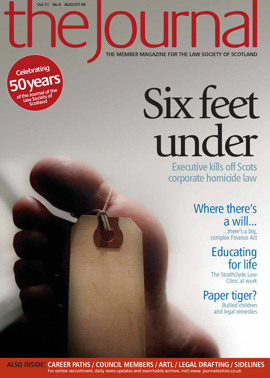Fighting the bullies

If we are to believe the media, reports of school bullying are on the increase. Although widely perceived as an educational rather than a legal issue, parents and pupils alike are beginning to look to legal redress where other attempts to resolve bullying have failed. There are, however, conceptual and practical difficulties to contend with: the continual emergence of new forms of bullying, such as “cyber-bullying” and “happy slapping”; the lack of any universal definition; the dearth of Scottish case law; and obscurity surrounding the nature and extent of school responsibility. These are just some of the challenges facing practitioners advising in this underdeveloped area of law.
What is bullying?
Identifying what behaviour constitutes bullying is essential, since liability will only be imposed where a wrong of a legally recognised and definable nature has been committed. The UK Government website describes bullying as “deliberately hurtful behaviour repeated over a period of time”. This may include text messages, internet, email or telephone communications. The Scottish Executive refers to bullying as intentional “words or actions” causing emotional or physical harm. The Scottish Council for Research in Education uses a child-centred definition which includes “saying hurtful things… hitting or kicking people… again and again”. What is not bullying is also important. The Anti-bullying Network states that it will rarely be considered bullying if two people of same strength argue or fight.
Education authorities have defined school bullying in various ways, but without a universally agreed definition, while statistics can mask the extent of the problem. Not only does the “bullying” have to be exposed, it has to constitute bullying in the eyes of the person reporting it and the authority recording it.
What do courts understand by the term?
Courts in the western world have tended to create their own definitions. In Mulvey v McDonagh [2004] IEHC 48 the Irish High Court adopted guidelines to Irish primary schools which described bullying as “repeated aggression, verbal, psychological or physical conducted by an individual or a group against others”. In the “Tonganoxie High School case” (US District Court, Kansas, filed May 2004) school bullying was defined as “harassment”, the pattern of which was “severe and pervasive… although some of the isolated incidents could be characterised as mere insults, teasing and name calling, collectively they reflect much more”. In England, Bradford-Smart v West Sussex CC [2002] EWCA Civ07 held that “uncouth behaviour… of a targeted and persistent nature” was required. In Scotland bullying has been described as “a pernicious phenomenon, often involving… criminal assaults by the bullies on their victims” (Montgomery v Cumming 1999 SCCR 178).
Although courts are united by their revulsion of the phenomenon, identifying precedent confirming behaviour which undoubtedly amounts to bullying in law is problematic. The picture is not wholly consistent. However, the words “deliberate”, “persistent” and “severe” recur. Where courts have been persuaded that behaviour can be described in this way, they have normally been satisfied that bullying has taken place.
“Deliberate” and “persistent” have been judged objectively. “Deliberate” encompasses the targeting of a particular pupil or group of pupils, and incidents have been interpreted as accidental where there is doubt over motive (Hunter v Perth & Kinross Council 2001 SCLR 857). “Persistent”, rather like “frequent” and “recurrent”, also creates difficulty. Some courts have specifically stated that “isolated incidents of aggressive behaviour… can scarcely be described as bullying”, while others have referred to patterns of persecution (Bradford-Smart; Mulvey, above). It is not clear from case law whether “severe” is an objective or a subjective benchmark. Although most definitions of bullying refer to the effect on the victim, it is safer to assume that a court will consider both the impact of the alleged bullying on the particular pupil and the expected impact on an average child. However, in cases involving, for example, a victim with special needs or emotional difficulties (G v Westminster City Council [2004] 1 WLR 1113), less evidence may be required to demonstrate “severe” consequences.
When do clients seek advice?
In the classic scenario legal action is a last resort. Clients most frequently seek advice on their legal options when other strategies, such as school meetings, anti-bullying policies, parental discussions, formal complaints, mediation processes, police or children’s hearing involvement, have failed.
Proceedings concerning school bullying normally arise at two different stages. First, courts have been asked to consider bullying around the time it surfaces, typically in the context of non-attendance or children’s hearing proceedings, although a Scottish court has granted interim interdict in an application by a pupil (Sheriff Fletcher, Perth Sheriff Court, unreported case, 1 May 2003). Secondly, children or adults raise subsequent proceedings for financial compensation where the issue is one of liability rather than resolution. The nature and extent of education authority responsibility is the focus of the majority of cases.
When might liability arise?
Specific legal accountability may not necessarily follow proof that bullying has taken place. Parental measures, such as withdrawing a child from school, can only be justified and pupils or former pupils can only obtain compensation where an education authority has failed in the exercise of its legal duties. One reason for the difficulty in establishing the breach of a specific legal responsibility is the existence of a plethora of legal personalities, capacities, powers and duties deriving from an assortment of common law and statutory sources.
If the victim and the perpetrator are both aged under 16, issues of legal capacity and childhood delictual liability arise. Various public law measures exist to address poor parenting, but Scots law has not yet provided a definitive answer on whether parents are responsible for negligent or deliberate harm by their children. In addition, parents and education authorities hold statutory duties to educate children adequately and efficiently with regard to age, aptitude and ability, and authorities must direct education towards developing the personality, talents and abilities of children, whether victim or perpetrator of bullying, to their fullest potential (Education (Scotland) Act 1980, ss 1 and 30, as amended; Standards in Scotland’s Schools etc Act 2000,
s 2(1)). They owe a further common law duty of care to children educated by them, whether in school or by other arrangement. These varied, contemporaneous duties generate a network of legal rights belonging to pupils: courts have not yet had the opportunity to determine the scope of many of these rights.
When they have done so, the boundaries of these rights and their corresponding responsibilities have rarely been drawn with any precision. Victims raising proceedings face at least three significant obstacles arising from a combination of legal, social, educational and public policy concerns.
The first obstacle, deriving from principles long present in the law of delict but underdeveloped in school bullying cases, concerns unease over the imposition of education authority liability for injury caused by a schoolchild. Courts have, on occasion, held education authorities liable for accidental injury to pupils at school, but there is general judicial reluctance to hold an authority responsible for injury arising from the deliberate action of another pupil (Taylor v Fife RC 1991 SLT 80; [2005] EWCA Civ 19). It is thought, following recent judgments on other educational issues, that such liability will only be imposed where there is “foreseeability of damage, proximity [or causation] and… it is fair, just and reasonable” (Carty). These three, fairly vague, factors are open to future judicial interpretation.
The second hurdle arises from more practical concerns: where do an education authority’s supervisory duties towards pupils begin and end? There is very limited statutory regulation regarding schools’ protective responsibilities in class time or recreational time, which might include after-school activities or excursions. Thus far, courts have been dubious about extending statutory or common law duties towards pupils victimised by other pupils outside school grounds. The court in Bradford-Smart held that there existed a discretionary, rather than an obligatory, duty to address bullying which took place on the way to and from school. However, it also said there was limited potential to hold an education authority liable where there had been a failure “to take such steps as are within its power to combat harmful behaviour of one pupil towards another even when they are outside school”.
The final obstacle concerns the identification of an appropriate benchmark, or standard, against which the actions of the school staff responsible for dealing with bullying may be measured. The standard of care in Scotland is generally believed to be that expected of “an ordinary, competent” teacher addressing bullying, although in other jurisdictions, such as Ireland, a different standard is thought to exist (Hunter, above; Ahmed v City of Glasgow Council 2001 SLT (Sh Ct) 153; Scott v Lothian RC 1998 GWD 33-1719; Mulvey, above). What is competent is determined with regard to the practice in existence at the time the bullying took place. This may be advantageous for victims of relatively recent bullying. In Scott Lord MacLean acknowledged, when considering a case involving a former schoolgirl who had been bullied in 1987, that anti-bullying practice within schools could develop considerably within a short time frame. Where an education authority now fails to exhaust the spectrum of contemporary good practice (potentially including “buddy” programmes, involving educational psychologists and police, peer and family mediation schemes etc), liability may be more readily imposed. McPherson v Perth & Kinross Council 2001 GWD 4-171 indicates that “ordinary” competence now includes operating an effective anti-bullying policy.
General scarcity of Scottish case law and judicial hesitancy to develop firm legal precedent means that the outcome of court proceedings is uncertain. One indisputable point does, however, emerge from case law. Advising clients to ensure that any incidents, together with identification of the alleged bullies, are reported and recorded is essential. The court in Montgomery held that a parent who failed to do this had “in effect made it impossible for effective steps to be taken to eliminate the bullying and so she herself contributed to it continuing”.
A potential for protection
In this age of human rights, increased litigation over school bullying is perhaps unsurprising. Adults deemed vulnerable for racial, sexual and health reasons have been granted various protections by statute and in Scottish courts. The idea that children, to whom an increasingly complex array of child protection regulations apply, do not deserve legal protection from their peers or compensation in the event of state failure to protect seems insupportable. Although certain statutory duties do not apply where children are privately educated, the potential for delictual liability exists whether children are bullied in state or independent schools. UK courts have also acknowledged that bullying “may” be actionable “either as a health and safety or an educational issue or both” (Bradford-Smart), but this offers little comfort to victims without an accompanying legal remedy. Undoubtedly the ideal place to beat school bullying is in school, and that is where the overwhelming majority of cases are resolved, but it is hoped that courts can be encouraged to provide redress in those tragic few situations where the system has failed children and young people.
Lesley-Anne Barnes is a lecturer in law at Napier University, Edinburgh
In this issue
- Ireland 4, Italy 0
- A lack of trust
- Technology and the Scottish courts
- For supplement read tax - an update
- Eyes on the ball
- Don't leave gaps in regulation
- Keeping company
- Fighting the bullies
- The university of life
- A lack of trust (1)
- With these few words...
- Tell it like it is
- All that sparkles ain't gold
- PDF is the standard
- The paper monster
- Safeguarding fair trial
- New law, new problems
- Raising the stakes
- Mark the pre-proof
- Scottish Solicitors Discipline Tribunal
- Website reviews
- Book reviews
- It takes two to tango
- Land attachment and suspensive missives
- PSG's suite moves






